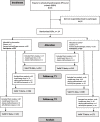Active play in ASP -a matched-pair cluster-randomized trial investigating the effectiveness of an intervention in after-school programs for supporting children's physical activity
- PMID: 32295569
- PMCID: PMC7161268
- DOI: 10.1186/s12889-020-08645-1
Active play in ASP -a matched-pair cluster-randomized trial investigating the effectiveness of an intervention in after-school programs for supporting children's physical activity
Abstract
Background: Interventions directed at after school programs (ASPs) have the potential to support physical activity (PA) in young children. Research has indicated that interventions that emphasize competence building among the ASP staff can lead to increased PA among the children. The present study evaluates the effectiveness of the Active Play in ASP intervention-a program for ASP staff aimed at supporting physical activity among first graders in ASP.
Methods: We used a matched-pair cluster randomized design and included 456 first graders from 14 schools in Norway. From these, 7 ASPs received the intervention (N = 229), while 7 acted as controls (N = 227). Measurements were taken at baseline, immediately post intervention (7 month follow-up) and after a year (19 month follow-up). The primary outcome was moderate to vigorous physical activity (MVPA), which was estimated with predefined cut points of counts per minute (CPM) and expressed as minutes/hour. Secondary outcomes were vigorous and light intensity physical activity (VPA and LPA) and sedentary behavior. The analyses of intervention effects were based on between-group differences in outcome changes between the 3 measurement points and were conducted using a mixed-effects model for repeated measures using categorical time. In exploratory analyses, we investigated gender, baseline body mass index, and baseline CPM as potential effect modifiers.
Results: No significant intervention effects was observed on MVPA (0.55 min/hour [99% CI -0.55:1.64]) or on the secondary outcomes, min/hour of LPA, VPA or sedentary behavior. Exploratory analyses indicated that among the 50% least physically active children at baseline, children in intervention ASPs reduced sedentary time from baseline to 19 months follow up by 1.67 min/hour (95% CI -3.12:-0.21) compared to the controls.
Conclusions: Although the intervention did not significantly increase the mean MVPA among the children in the intervention ASPs compared to controls, it did seem to have a small effect by reducing sedentary behavior time among the least active children. An even stronger emphasis on how to identify less active children and support their activity may be needed in order to increase their PA and further reduce sedentary behavior time.
Trial registration: ClinicalTrials; NCT02954614, Registered 3 November 2016, -Retrospectively registered, first participant enrolled August 2016.
Keywords: Accelerometer; Activity support; After-school programs; Physical activity; Physical activity play; Sedentary behavior; Self-determination theory.
Conflict of interest statement
The authors declare that they have no conflict of interest.
Figures



References
-
- World Health Organization (WHO). Global strategy on diet, physical activity and health. Available from: https://www.who.int/dietphysicalactivity/physical_activity_intensity/en/.
-
- Ommundsen Y, Løndal K, Loland S. Sport, children and well-being. In: Ben-Arieh A, Casas F, Frønes I, Korbin JE, editors. Handbook of child well-being. Dordrecht: Springer Reference; 2014.
-
- Gallahue DL, Ozmun JC. Understanding motor development : infants, children, adolescents, adults. 6th ed. Boston. London: McGraw Hill; 2006.
-
- Stodden DF, Goodway JD, Langendorfer SJ, Roberton MA, Rudisill ME, Garcia C, et al. A developmental perspective on the role of motor skill competence in physical activity: an emergent relationship. Quest. 2008;60(2):290–306. doi: 10.1080/00336297.2008.10483582. - DOI
Publication types
MeSH terms
Associated data
LinkOut - more resources
Full Text Sources
Medical
Miscellaneous

